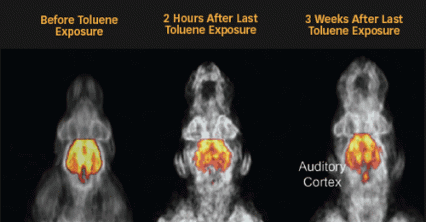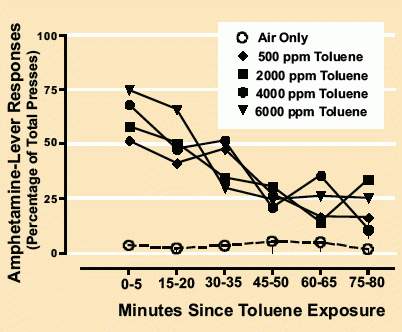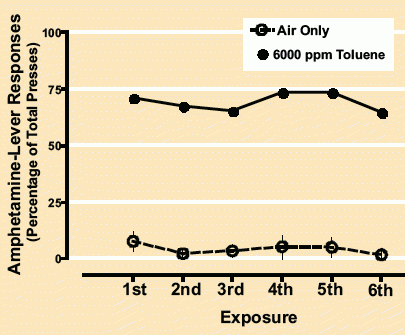Toluene, a solvent found in paint removers, glues, and other common household products, is often the first substance abused by young people, who inhale its dangerous fumes. A recent NIDA-funded study has shown that toluene's behavioral and neurobiological effects bear similarities to those of both stimulants and depressants, while another study mapped the drug's impact on brain metabolism. The findings lay groundwork for new prevention strategies.
Various animal studies have indicated that abused inhalants have subjective effects like those of central nervous system depressants. Now, Dr. Scott E. Bowen at Wayne State University in Detroit has demonstrated that, in adult mice, the subjective experience of toluene also, in some ways, resembles that produced by amphetamine. Dr. Bowen injected mice alternately with amphetamine and saline and trained them to seek rewards by pressing the correct lever—one after amphetamine and the other after saline. He showed that under the influence of toluene, the animals pressed the drug-associated lever, indicating that the inhalant felt something like amphetamine to them (see image below).
Dr. Bowen's findings add to emerging evidence that, in addition to its depressant effects, toluene induces stimulant-like behavioral effects (e.g., increased locomotor activity) by augmenting dopamine activity in the brain's reward pathway ("Dopamine Enhancement Underlies a Toluene Behavioral Effect (Archives)").
 Repeated Toluene Exposure Depresses Brain Activity: Researchers used microPET imaging to compare brain activity of a rat before and after chronic toluene exposure. Yellow indicates high activity. Three weeks after the last exposure, the brain showed recovery, but activity in the auditory cortex and some other areas remained depressed throughout the 2-month study.
Repeated Toluene Exposure Depresses Brain Activity: Researchers used microPET imaging to compare brain activity of a rat before and after chronic toluene exposure. Yellow indicates high activity. Three weeks after the last exposure, the brain showed recovery, but activity in the auditory cortex and some other areas remained depressed throughout the 2-month study.After exposure to the highest concentration of toluene—6,000 parts per million (ppm)—the animals' lever-pressing responses indicated that they were still experiencing stimulant-like effects 15 to 20 minutes later, says Dr. Bowen. When tested again 30 minutes after exposure, the lever-pressing responses of the mice were similar to those after saline, suggesting that toluene's effects had worn off.
"Dr. Bowen's results indicate that toluene and amphetamine share, to some extent, similar subjective effects, which may reflect a common neurochemical action," says Dr. Minda Lynch of NIDA's Division of Basic Neuroscience and Behavioral Research. The finding is worrisome because, in animals, exposure to one stimulant often enhances the response to another stimulant experienced subsequently. "Young people who abuse inhalants may increase their risk for later drug abuse," says Dr. Lynch. "An important next step is to determine whether animals exposed to inhalants, particularly during adolescence, are then more prone to use stimulants upon exposure."
Toluene Depresses Brain Metabolism
In a separate NIDA-funded study, Dr. Wynne K. Schiffer and colleagues at Brookhaven National Laboratory and New York University School of Medicine used positron emission tomography (PET) to measure brain metabolism in adolescent rats exposed to toluene.
During the 2-month study, the researchers tested the effects of repeated exposure to toluene at a dose they previously established to be rewarding to adolescent animals. Two hours after the last toluene exposure, the animals' whole-brain metabolic activity had declined 20 percent compared with levels seen prior to exposure and with those of control animals. Metabolic activity in the brain continued to drop, reaching 40 percent below baseline after 24 hours; at this time, brain regions involved in movement coordination, memory, and learning showed the greatest effect.
The depression in overall brain activity persisted for a week. Two months after the last exposure, the now-mature rats showed recovery of overall brain metabolism. However, activity in the temporal cortex—an area involved in the processing of sounds and memories—remained about 10 percent below the baseline level.
"In humans, PET imaging has revealed a great deal about the characteristic metabolic signature of the addicted brain—that is, one can immediately see by the pattern of depressed activity in particular brain regions that a person has abused cocaine or alcohol. Our findings indicate that repeated toluene exposure has a similar signature, further linking its neurobiological effects to those of traditional drugs of abuse," says Dr. Schiffer.
"Dr. Schiffer's findings help shorten the list of brain areas we need to examine during future studies of toluene and may guide research on the drug's distribution in the brain and the changes that underlie its behavioral effects," says Dr. Rao Rapaka of NIDA's Division of Basic Neuroscience and Behavioral Research.
Toluene Has Amphetamine-Like Effects
Drug Discrimination Training
Adult mice in a training chamber learn to press levers for a milk reward. To receive the reward after a saline injection, they must press a certain lever; to receive the reward after an amphetamine injection, they must press a different lever. The trained mice thus signal, by their choice of levers, which substance they have just experienced.
Scientists can find out if a test substance feels like amphetamine to the mice by injecting the test substance and determining whether mice respond to the amphetamine-linked lever or the saline-linked lever. If response to the drug-associated lever is high (around 80 percent of total lever presses), the scientists conclude that the test agent feels like the drug to the mice. An intermediate response (60 to 79 percent) indicates that the test agent feels somewhat like the drug.
Toluene Exposure And Testing
To test a substance like toluene, which is not injectable, scientists let the mice inhale it and then return them to the lever-equipped chamber. A high level of responding on the drug-associated lever indicates that toluene exposure and amphetamine exposure feels similar to the mice.
Results

All concentrations of toluene elicited amphetamine-linked lever-pressing behavior, and similarity to amphetamine increased with toluene concentration. At the highest concentration of toluene, mice continued to feel its stimulant-like effects for at least 20 minutes.
In the first experiment, mice received either air only or toluene vapors during a 10-minute exposure. Immediately after the exposure, mice were placed in the test cage for 5 minutes to measure their lever-press choices. They were then removed for a 10-minute break in a cage with no toluene and no levers. The animals experienced alternating assessments and breaks for 80 minutes.
In a second experiment, mice received six 10-minute exposures to either toluene or air. After each exposure, the mice were placed into the test cage for 5 minutes.
Toluene's toxicity with chronic exposure and its availability in household and industrial products drive scientists' efforts to identify the mechanisms that underlie its abuse. Clinical reports have linked chronic toluene abuse with a profound reduction in brain white matter, together with associated neurological problems such as impaired movement, cognition, hearing, and vision.
"Toluene appears typical of abused inhalants and may have the greatest potential for abuse and damaging effects," says Dr. Schiffer. Because of their usefulness as solvents and for other practical purposes, toluene and other abused inhalants are not likely to become less available, says Dr. Bowen. "Prevention efforts with youth and further research on the neurobiological and behavioral effects in animals, particularly during gestation and adolescence, are keys to countering the problem."
Sources
Bowen, S.E. Increases in amphetamine-like discriminative stimulus effects of the abused inhalant toluene in mice. Psychopharmacology 186(4):517-524, 2006. [Abstract]
Schiffer, W.K., et al. Metabolic correlates of toluene abuse: Decline and recovery of function in adolescent animals. Psychopharmacology 186(2):159-167, 2006. [Abstract]

